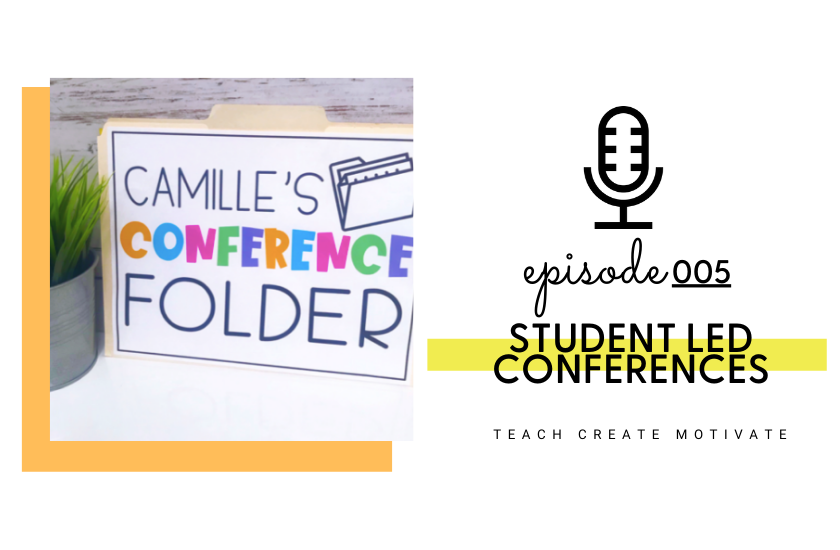
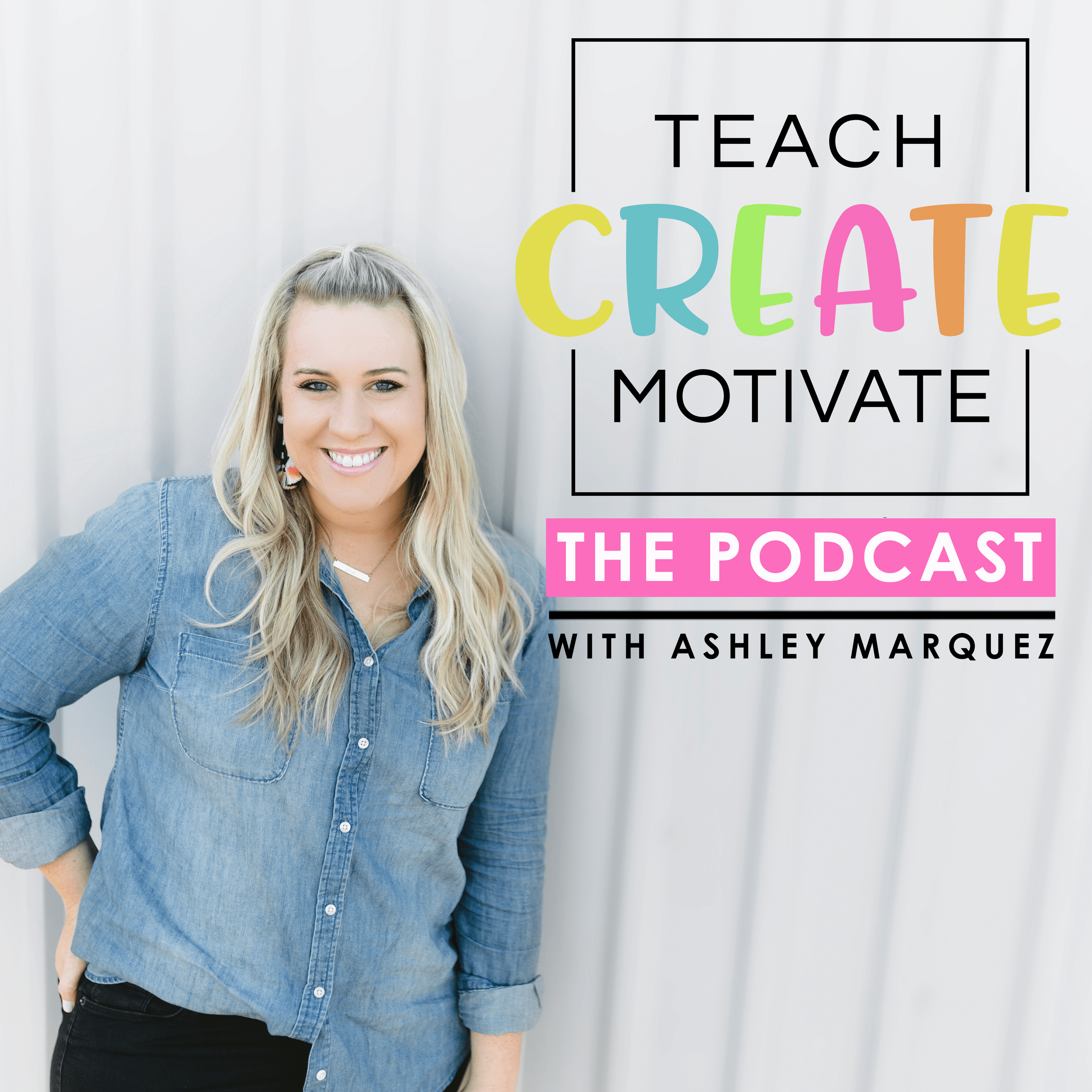

Teach Create Motivate Podcast
Student Led Conferences
Show Notes
I want to talk about something really exciting, something that I love sharing about and that’s student-led conferences. Now, wait… don’t stop listening here. I know some of you might want to but wait a second. I’m gonna be talking about many, many things that you can also take and use in your normal parent-teacher conferences if you aren’t quite ready to jump into the world of student-led conferences but let me just tell you…. It is SO worth it. I promise you, there are so many benefits to this that I love to share and I can’t wait to share with you today. Whether you teach kindergarten or sixth grade, I highly, highly, highly, HIGHLY recommend trying this with your students and your parents and I say parents too because parents are the main focus of a parent-teacher conference but bringing in your students into that is just so amazing to watch and beneficial.
Now, I know what you’re thinking okay, but this is going to take so much more time for me and as a teacher I don’t have time to spare. I know that we don’t. But no, it really doesn’t. It really truly doesn’t take much more time at all to prepare for a conference like this, especially with the way I’m going to recommend doing it. Everything I talk about today I’ve used with my students in my classroom so it’s coming from a place where I’ve actually done this and it’s proven to be very successful and I’m telling you, my parents loved this. They loved watching their child soar and take this independence and I loved watching it too. I loved watching them take ownership and if you’re new around here, student ownership and student independence and leadership is my jam. It’s the most important thing that I love talking about so this was the best thing ever to see with my students.
Alright guys, let’s talk conferences!
So first, I just want to think about have you ever really thought about the power of a student-led conference? Have you thought about what that could mean for you and your students and the parents that you have in your classroom? Parent-teacher conferences are a great tool obviously for the success of our students. I know that a lot of us do parent teacher conferences twice a year. Some of us do them once a year. I know that some of us do them in the spring, some of us do them in the fall, some do them both times. It varies. I have talked to a lot of teachers and I think this is a huge thing that varies so I know for me, I do them personally in October. And we used to have a conference day in the spring as well, but my district actually got rid of that for certain grades so I only have one a year. But I know a lot of you guys have them twice a year, or even if you do have them once it’s actually the March time of the year. So, even if you’ve already had your conference or you’re listening to this and you’ve already done this, it’s okay. You can just file this away for next year. But as teachers, we meet and talk with our students’ parents frequently throughout the year. Obviously we have different ways of communicating with them. But a lot of us have a set day or days to meet with them on a conference time, a conference day. So I have always done this parent-teacher conference thing the typical way. When I say typical way, I mean I prepare what I need to share with them and I block out my time and I just have back-to-back parent conferences with just the parents that choose to come or that families that come for the student. So I met with each parent or family individually and shared their child’s data, their grades, their behavior.. And that’s totally great, that’s awesome. Again, like I was saying, everything I say today you can take back regardless of if you do a student-led conference or not but that’s what I always did because that’s kind of what I was always told to do or what everyone around me was doing. And again, nothing wrong with that, that’s just kind of why I did that. So I wanted to kind of reevaluate that and I was telling myself well, why am I not trying student-led? It’s because it seems like a lot of work, seems like a lot more effort and time and no one else is doing it so I’m just gonna keep doing what I always do. But I decided to change it up and I’m a huge advocate for student leadership and I’m a huge advocate to student independence. I’m already doing so many things that have to do with student independence in my classroom everyday and I will share a lot more about that on this podcast and my blog has a lot of stuff and on my Instagram so you can see a lot of that in the things that I share and more to come. But I’m already doing that in my classroom and I see great benefits from that so why not bring that to conferences? Because I feel like, that’s a great opportunity for my students to do that even more. So in my classroom, like I said, I do this already like self-reflections, class jobs, student choice in stations. Students thrive when you give them to reigns to something so I can tell you after applying this to student-led conferences, I will never back to back to a regular parent conference. That’s how powerful I feel like this truly is. So I want to tell you why and then I want to tell you how you can do it and what you can do to make it happen.
My Why Behind Student-Led Conferences
So, here’s my why. I saw my students thrive and shine. They literally took the lead in the discussions with their parents. I didn’t even have to help them very much at all during the actual conference. They facilitated the one-on-one conversation between their mom and their dad or their family member. So they shared their goals, they shared their favorite best work that they were proud of. They shared the favorite things they loved about our school and our classroom and our grade. But they also shared areas where they want to get better at school-related and other areas. I mean, I’m talking third graders so them to do all of this on their own.. Obviously I guided them up until the point of the conference but to watch them do this with their parents, it was amazing. The first conference that I had, because again it was my first time, so the first conference I had I almost cried. I was so proud of my little third grader that I had only been with for a couple months because again, my conferences were in the beginning of the year and I just would watch the parents’ face while they were talking to their student and they were really listening. It’s not that they were surprised because obviously it’s their child but I think they were surprised that in a school setting like this, their child thrived and had so much ownership and was doing such a great job.
So did I tell you I teach third graders? Yes, it was a very, very rewarding choice and I’m proud that I made that choice because of all the benefits that I saw. So I have a lot of things that I did to get that point but it wasn’t like it took so much class time so I want to share with you the things that I did. And I want to touch on the fact that obviously I did still share data and my own information with parents. That has to happen. So this isn’t taking the place of you sharing that with the parents. Again, this is my personal experience and opinion so I’m just sharing what worked for me. But for me, the first ten minutes, they started us off. They shared all of that in the ten minutes and then once that time was up, it was my time to talk and almost every single student got through all of the things they needed to share. So then I took over and I shared the data and the grades and any concerns or positive things and I’ll share more about that in a second. But again, they’re sharing and I’m sharing and it’s a two-way thing. I let them start because I don’t want them just sitting there while I’m talking, kind of getting nervous or not sure what’s gonna happen. So they start out the conference.
What You Need to Get Started
So I want to share with you what I use to help me facilitate this in my classroom and how you can do it too. I have different worksheets, they’re not really worksheets, but I have different forms and pages that I’ve created to have my kids work on for about a week up until their conference and the things I’m gonna share with you that they do, you don’t have to do all of them, but they all were a great piece, they played a great role in the conference and the time that I took for my kids to do this was during morning work. A lot of this was done during morning work or at the end of the day, when my kids finished an activity, even a station like an LA station because it’s a lot of writing. So you can fit these things in your day, a little bit each day, up until conferences. You don’t have to take an entire learning day to do all of this. And this is what I mean when I say if you’re not gonna go the student-led route, which is okay, these pieces that I’m going to show you and share with you that really work, you can still have your kids do and then you will just share it with parents if you’re not ready to have the kids come in or if it’s just not going to work for you this year or whatever… you can still use these pieces to make your conferences just more meaningful.
Self-Reflection
So the very first thing that I do and it’s my favorite part of the conference is a student self-reflection. Self-reflecting is so powerful like even as educators and human beings, the age that we’re at, whether you’re starting out in your teaching career or you’ve been teaching for 20+ years, we always need to be self-reflecting. We need to be self-reflecting on what’s working, what’s not working, how are we doing, how can we get better, what are we doing that’s amazing. So that’s what I have them do. I have a ten step self-reflection where they just rate themselves on some areas in the classroom like managing their time or their work or their voice level or their friendships. Lots of different things where they just rate themselves and then they write a goal for themselves. So they’re self-reflecting, again, that takes like five to ten minutes to give them that self-reflection. And before I started student-led conferences I had given them this self-reflection and then I shared it at conferences. And that’s kind of what gave me the kick in the pants that I needed to do this because I saw this self-reflection was so amazing and I was like, okay I have all these other things that they could be doing to lead this time with their parents.
3-2-1 Question Stems and Goals
So self-reflection is the very first thing I give them and then I move on to some other things. So I have them do a 3-2-1. Again, these are just some questions about their year, describing how they feel about the year, telling their best things they love, things they want to get better at. And then, I have them do goals. So, I have all of these resources by the way, for you, where you can just grab it and get started and print. So when I say what I’m doing, just remember that whatever I’m saying there’s other options in this resource if you decide to grab it and go with it. For example, I have my students write a math, a reading and an “other” kind of goal but you could always edit that to fit your needs or fix it to be what you need it to be. But I personally have my students write a math goal and a reading goal and then another goal so it could be a soccer goal. It could be a goal with a friendship. It could be anything so that’s something else that I have them do. So that’s already three pieces that they are filling out and having to share.
Note to Families
Another thing that I like to throw in there, it’s not really necessary but it’s a good way to get the conversation started with them, is a note to their parents or family. So they just write a little note to them and a lot of my kids chose to just thank their parents or their families for supporting them and helping them with their homework. I had a lot of kids say thank you for helping me get to school on time. I mean, that’s kind of where they’re coming from as a third grader so that’s a nice little thing to throw into the conference as well.
Work Samples
And then the last thing that I have my students do to share with parents is I give them a checklist of different work sample ideas. So for example, I put on there their reading response notebook, selfie writing, a project that we’ve done together, their science notebook. Things that they have completed that I know that they would maybe want to share and I have them pick two or three. And the reason I give them a checklist is because it might be something that I need to make available to them at the conference or it might be something that they need their Chromebook to show but it helps me know what I need to gather or if I need to gather something. And then this way they know what work are they going to show, what are they most proud of and what are they gonna share with parents. And then I’ll get to how we prepare for the actual conference time. But this way they have a self-reflection, the 3-2-1 question stems, they have a goals, they have a note to their parents and then they have work to share. So that’s plenty of things to take up their ten minutes but it still shares so much with parents that they might not hear or see if it were just me talking to them.
My Turn to Share
So then personally what I share in my conferences is their data so I share their MAP data, which is a like computer-based test that we take. I share their scores and I share what the scores mean, I share their grades if they haven’t been able to check the grades. And then I share GLOWS and GROWS. So I pick two or three glows, things that that students is doing so well at and I pick one, to two, to three grows, things that I think they really need to work on. And I personally share the glows and the grows with my students before the conference because I want them to know what I’m going to be saying to their parents and I want them to be apart of them. And sometimes I even say to them, “hey what do you think I should put down for your grow to share with your mom and dad or your family because I have an idea but I want to hear what you have to say or honestly, I don’t know what to put as a grow for you so what would you like to put so we can talk to your parents?” So it is a very inclusive process, they are included in everything. And then I take all that, as well as some at home student practice, like a little handout that I give that has what they can do at home and I just put it in a folder for each student and that student will use their folder to share at the conference and then I will just grab my pieces of out the folder when it’s my turn to share.
Now I want to tell you kind of how I have them prepare for the conference but before that, I did want to mention, I do send home a letter to my parents about what we’re doing because I know for a fact that my personal class of parents didn’t ever have a student-led conference. So I included a letter, and again these pages and templates are all available in the resource I already created because I used it with my kids and it’s available to you. But in the letter I told them what the conference was, like what a student-led conference is, as well as why it’s so important that their child will be there during the conference. I sent that letter home, as well as the way to sign up. So I personally used SignUpGenius, it’s a website for conferences and I send home the website and a QR code that reminded them to sign up along with the letter. And the last thing that I sent home altogether was a pre-conference survey. Now this is obviously the first time I’ve done this but it was great. This was just a quick set of questions for my parents to answer about what they wanted to hear or learn more from during our time together or if they had any specific questions. Most of them didn’t really have much to say or ask, like there weren’t too many concerns but for the couple that really had something specific, I knew I needed to make some time for that at the end of the conference. So that’s what I send home before and then I have my kids work on all that stuff that I had mentioned just a second ago. And then this is when we get to start preparing for the conference.
Show Us What You’ve Got!
This is the most important thing. When you’re giving independence to your students in any area, you’ve gotta give them time to learn it… time to master it, right? So I couldn’t just give my kids a student self-reflection, a 3-2-1 sheet, goals and say “Okay, I’ll see you next week at your conference. You’ll be ready!” Like no, I need to give them some time to practice their conference and this was vital because it really showed them, “woah I can do this! This is fun! This is easier than I thought! I’m just talking about myself, right? I’m not talking about anything that’s hard to talk about, I’m talking about me. And now that I’ve done it once or twice, I’m fully ready to do this with my parents.” So this is what we did. I gave my kids an outline, a page, I did not make the outline for them. I gave them a page and I said to them, “Okay, if I were you, here is the order of which I would do my conference in.” And I told them, I said, “I would start with my letter to my parents, read them the letter or give them the letter, whatever I want to do. And then I would talk about my self-reflection. And from there, I would talk about my 3-2-1 and my goals, and I would end my time sharing my favorite work samples.” And so I told them that and I said “Now you can do it in whatever order you want to but here’s what I need you to do: on your outline, I need you to write it in order, which activity or which thing you’re gonna talk about first and then obviously what comes after that and then next to that I want to write an amount of time. So my letter to my parent should not take me more than a minute to talk about, my self-reflection should not take me more than 1-3 minutes to talk about, depending on how much detail I want to talk about my reflection. So I told them on their outline page, which they filled out on their own by themselves, I told them to write in order what they’re gonna say and how much time and the time added up should not equal more than ten minutes. So this was super helpful. And then once they had that, I had their folder with all their stuff and their outline and I let them gather their work because at this point it was getting closer to the conference so for them to gather their notebooks or whatever they wanted to share, I had them do that. I was okay, it wasn’t like it was two weeks before and then I needed them to use it the next day or whatever. So I had them gather it and then I had them partner up. Now, they partnered up because they had a couple times to practice using their outline and their folder of materials sharing that information. And this was the first time that they were doing that and I walked around and I was listening and I was like “Oh my goodness. Like, I’m so happy I did this!” I feel like this was the best choice I had made in a while as a teacher because this is their is first time practicing it and they are already rocking it! So then they kind of were able to listen to someone else and give some feedback to that person like “Hey! You spend seven minutes talking about your goals like maybe you need to spend a little less time.” They also were able to see in themselves like okay I need to spend more time here or I want to share a little bit more about my reading response so I need to cut off some time here. It sounds really complicated, but it’s not. They get it. They learn to do this. So letting them practice one to time times before their conference is a really, really, really good idea so I highly recommend that.
Putting All the Pieces Together
So then after they’ve shared and we’re ready to go, I have them give me their conference folder with their pieces of paper in order, with their outline on top, and gather the work they want to share, if it’s a notebook or something that’s not in a Chromebook or something that I need to pull up for them on my computer. I have them gather it. And then I put them in stacks in order of my conferences so I also have a sheet that I keep for myself that is my schedule. So next to each time I put the name of the student and the parent that I know who’s coming in and I put the folders in order so all I have to do is grab that student’s folder, take out my pieces, which is the data and the glows and the grows, and any running records or spelling inventories that I want to share, take that out and then have the folder ready for them when they come in.
This made it easy; I was organized that way and I wasn’t scrambling around. And then what I did is I just pulled some tables in the middle of our classroom and at the end of every day, if I had conferences after school I had students help me do that. And if I had a conference right after school I had that student get their stuff and put it out. And they were so excited, like they were really excited. And that way we were ready to go and we had a place to sit and we had all of our materials and everything.
So the amount of positive feedback and during these conferences and afterwards that I received from parents and even from my own students and the proud looks on my students’ faces, it was so worth it. I’m telling you all the stuff that I just shared that you can do for student-led conferences didn’t take very much extra time at all and it was so beneficial and it was so meaningful. And I was still able to share what I needed to share in the 5-10 minutes after they talked that I don’t see a reason why to never do it this way.
Now I told you guys that if you don’t want to do the student-led yet or you’re not wanting to try that, you can still have your students do the self-reflection and the goals and the 3-2-1. You can still have them do those things and you can just share it for them or send it home at the conference. So I really recommend if you don’t want to do student-led to do these pieces, to give your students more of a ownership in the conference season. I’ve done all this hard work for you and I have created those simple and effective pages and forms for your kids and you! There’s a lot of stuff in there for you to get organized too. And this will just help you and your students to prepare for the conferences. So I’ll leave that link below if you want to check those out. But ultimately I will never ever go back to other types of conferences. I hope you can take something from this and apply it.
And I have an exciting thing for you actually. I made the goal sheet that I use with my kids, the actual goals page that I use from that resource, I pulled it out as a freebie for listening. I will leave the link below for you to grab the freebie or you can just go to teachcreatemotivate.com/freegoals and you will be able to grab the goals sheet and you will just need to enter your email and your name and grab that. If you’re already a part of the email list, it is in the free resource library. This is something that you get as being an exclusive member of the email family, so just make sure to check your email for the password.
But other than that, again, I hope that you guys enjoyed this episode and that if you have conferences coming up that you try this. It doesn’t take much extra time. You have time to try it. And if you already had your conferences, maybe keep it in mind for next year.
Let me know if you have any questions regardless student-led conferences. As always, thank you so much for listening and joining me on this podcast. Hope you love it! Happy Teaching!
Links Mentioned in this Episode
Listener Spotlight

Subscribe and Review in iTunes
Have you subscribed to the podcast? I don’t want you to miss an episode and we have a lot of good topics and guests coming up! Click here to subscribe on iTunes!
If you are feeling extra kind, I would LOVE it if you left us a review on iTunes too! These reviews help other teachers find the podcast and I truly love reading your feedback. You can click here to review and select “Write a Review” and let me know what you love best about the podcast!
 END OF YEAR ACTIVITIES!
END OF YEAR ACTIVITIES!


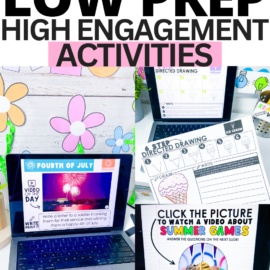
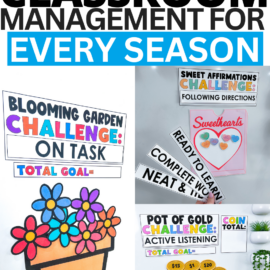
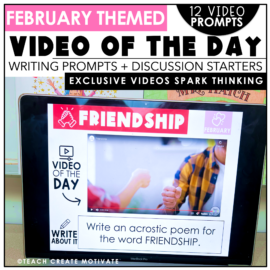
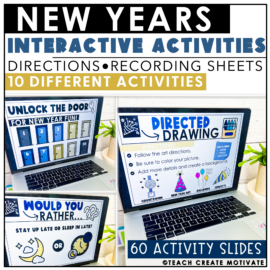
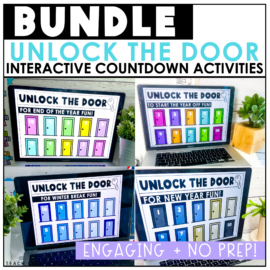
Leave a Comment